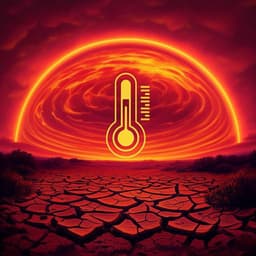
Earth Sciences
Increased risk of flash droughts with raised concurrent hot and dry extremes under global warming
Z. Zeng, W. Wu, et al.
This research, conducted by Zhaoqi Zeng, Wenxiang Wu, Josep Peñuelas, and others, explores the alarming rise in flash droughts worldwide, revealing their rapid onset, increased frequency, and longer duration. The study highlights the urgent need for improved climate models to better understand these swift climatic shifts and their implications for agriculture and ecosystems.
~3 min • Beginner • English
Introduction
The study addresses how flash droughts—droughts with rapid onset and intensification—are changing under global warming. Traditional droughts develop slowly, but recent evidence shows rapidly developing events driven by precipitation deficits and/or heat waves can occur within weeks, causing substantial agricultural and ecological impacts. Warming increases atmospheric water demand and strengthens land–atmosphere feedbacks, potentially making flash droughts more prevalent, faster, and longer. The authors highlight a likely shift in climatic background after 2000, with rising vapor-pressure deficit, more frequent heat waves, and increased perturbations, which could accelerate soil moisture depletion and increase the chance of flash droughts evolving into seasonal droughts. The key research questions are to quantify global and regional changes in flash drought characteristics (frequency, duration, seasonality, onset speed) between 1981–2000 and 2001–2020; to assess exposure of agriculture, forests, and populations; to attribute drivers (precipitation deficits, positive temperature anomalies, and their concurrence); and to evaluate CMIP6 models’ ability to reproduce flash drought characteristics and drivers.
Literature Review
The paper situates itself within a growing literature that recognizes flash droughts as rapidly developing droughts with severe impacts. Prior work developed diverse monitoring indices (e.g., Standard Evaporative Stress Ratio, Evaporative Stress Index, Rapid Change Rate Index, Evaporative Demand Drought Index, short-timescale SPI/SPEI, solar-induced chlorophyll fluorescence trajectories, and soil moisture anomalies). Root-zone soil moisture anomalies are considered especially effective for onset characterization and impact assessment. Recent studies found increasing frequency of flash droughts and a possible global transition from slow to flash droughts, largely attributed to anthropogenic warming. Post-2000, rising VPD and more frequent heat waves have been reported, implying altered mechanisms and risks. The paper notes gaps: limited comprehensive comparison of flash drought characteristics and drivers before vs after 2000, and insufficient quantification of global-scale impacts on agriculture, forests, and populations.
Methodology
Data and periods: The study analyzes 1981–2020, splitting into 1981–2000 and 2001–2020. It uses: (1) FLUXNET2015 in situ daily soil moisture, temperature, and precipitation from 36 sites (473 site-years; 1996–2014) covering grasslands, croplands, deciduous broadleaf and evergreen needleleaf forests; (2) two global root-zone soil moisture datasets: GLEAM v3.5a and ERA5 (top 1 m), both aggregated to daily and 1°×1° grids; (3) ERA5 daily precipitation and temperature for driver attribution; (4) CMIP6 outputs from 22 Earth system models (historical 1981–2014 and SSP5-8.5 2015–2020) interpolated to 1°×1°; (5) exposure datasets: population (1 km; 2000 and 2020), cropland and pastureland fractions (10 km; 2000), urban extents (0.0083°; 2000 and 2020), and tree cover (1 arc-second; 2009). Population and land-cover rasters were aggregated to 1° to match climate grids.
Definition of flash drought: Using pentad (5-day) means of root-zone soil moisture. A flash drought is identified when soil moisture declines from above the 40th percentile to below the 20th percentile within ≤4 pentads, with a mean decline rate ≥the 5th percentile threshold for each pentad during onset; the below-20th-percentile condition must persist for ≥3 and <12 pentads (to avoid short dry spells and to distinguish from seasonal droughts). If duration ≥12 pentads, the event is considered to have transitioned into a seasonal drought. Onset time is t0–t1; duration is t1–t2.
Event metrics: Frequency (number of events), onset speed (distribution of events developing within 1–4 pentads), seasonality (by onset month), duration (pentads), and transitions to seasonal droughts. Global/regional yearly accumulated flash-drought occurrences (AFDs) were area-weighted to assess temporal trends and changes between periods.
Driver attribution: ERA5 precipitation and temperature were aggregated to pentads, standardized over 1981–2020. For each flash drought, mean anomalies during onset (t0–t1) were computed. Classification thresholds: precipitation-deficit flash drought (precip anomaly < −0.5 and temperature anomaly < 0.5), heat-wave flash drought (precip anomaly > −0.5 and temperature anomaly > 0.5), and concurrent hot and dry flash drought (precip anomaly < −0.5 and temperature anomaly > 0.5). Threshold choice (±0.5) balances attribution coverage (~70% of events) and stringency.
Dependence analysis: The dependence between pentad precipitation and temperature was quantified using Pearson correlation and bivariate copulas. All 39 copula families were fitted per grid cell (best by BIC; VineCopula R package). The joint probability of 5-day precipitation ≤10th percentile and temperature ≥90th percentile was computed, and a likelihood multiplication factor (LMF) was defined as the ratio of the copula-derived joint probability to the independence value (0.01), with LMF>1 indicating positive dependence increasing concurrence.
Sensitivity of soil moisture: Partial correlations assessed the sensitivity of 5-day soil moisture to precipitation and temperature while controlling for the other variable. For CMIP6, metrics were computed per model and then ensembled for comparison with observation-based datasets.
Exposure calculations: For each year and grid cell with flash drought, exposures were computed as the sum over pentads under flash drought multiplied by the area of cropland, pastureland, or forest within the grid (fixed land-cover baselines: cropland/pastureland 2000; tree cover 2009). Population exposure summed pentads × population counts (2000 for 1981–2000 baseline; 2020 for 2001–2020). Urban population exposure additionally weighted by urban extent fraction. Regional composite exposure maps were created by normalizing agricultural, forest, and population exposures within each of 26 IPCC regions and averaging the normalized components.
Model evaluation: CMIP6 models’ flash drought frequency, onset speed, transitions to seasonal drought, and driver composition were compared to GLEAM/ERA5-based diagnostics for both periods. Spatial differences, probability distributions, and accumulated occurrences by driver type were assessed.
Key Findings
- Observed trends and characteristics: Using FLUXNET, 393 flash droughts (≥3 pentads) were identified across 36 sites (1996–2014), showing a significant increase in normalized frequency in the last two decades (p<0.01). Most onsets occur in spring (27.2%) and summer (27.7%); winter has the lowest probability. A large fraction developed within one pentad (35.1%) or two pentads (34.6%), evidencing faster onset. Events starting in summer and autumn had higher chances (16.2% and 27.6%) to evolve into seasonal droughts.
- Global reanalysis results (GLEAM/ERA5, 1981–2020): Frequency and affected areas increased markedly, especially post-2000. The global mean share of events developing within one pentad rose from ~10% in the 1980s to >20% recently; events needing three or four pentads declined. The number of flash droughts transitioning into seasonal droughts doubled in recent years, with a surge after 2018. Areas prone to flash droughts include the Amazon Basin, southeastern North America, northern/central-eastern Europe, central Africa, and southern/southeastern Asia; humid and vegetated regions (Amazon, Congo) saw large frequency increases post-2000. Seasonality shifts show more events in late spring/early summer in the Northern Hemisphere and late autumn/winter in the Southern Hemisphere. Detrending soil moisture showed similar increases post-2000, indicating long-term soil moisture trends contributed little to the accelerated onset in the last two decades.
- Exposure increases (2001–2020 vs 1981–2000): Agricultural exposure increased by 20.3%. Global averages exposed per year: cropland 5291 km² (vs 4793), pastureland 9345 km² (vs 7374). Forest exposure increased by 17.1% to 11,292 km² per year (vs 9649). Population exposure rose by 30.0% from 2.03 to ~2.63 million people per year. Urban population exposure increased from 0.05 to ~0.12 million per year; largest increases in eastern Asia, central Europe, eastern/northern America, southern and southeastern Asia, and the Mediterranean. Regionally, strong increases in forest exposure occurred in the Amazon (34,349→41,788 km²/yr), western Africa (12,976→26,176), eastern Africa (8089→14,350), and central Europe (9174→13,038). Agricultural exposure rose notably in central Asia (25,522→34,833), southeastern/south America (18,764→30,834), eastern Africa (23,489→31,656), and central Europe (15,238→24,262). Population exposure increased especially in eastern Asia (7.9→12.2 million/yr) and southeastern Asia (6.0→6.8 million/yr).
- Drivers: Globally, precipitation-deficit flash droughts accounted for 33.19% (1981–2000) dropping to 26.0% (2001–2020); heat-wave flash droughts increased from 9.89% to 15.3%; concurrent hot and dry flash droughts increased from 24.5% to 34.13%. Regionally, concurrent hot–dry conditions dominated in the Amazon, northeastern Brazil, western Africa, and northwestern America in both periods, with shares increasing (e.g., Amazon 37.0%→48.9%). Many regions shifted from precipitation-deficit dominance (pre-2000) to concurrent hot–dry dominance (post-2000); only Sahara, southern Australia, southeastern and west-coast South America, northeastern America, and northern Europe remained precip-deficit dominated across both periods.
- CMIP6 evaluation: While CMIP6 reproduced broad spatial patterns of flash-drought-prone regions and overall frequency increases post-2000, models failed to capture the acceleration of onset (1–2 pentads) and the rise in transitions to seasonal droughts. CMIP6 greatly underestimated flash drought frequency over ~85.1% (1981–2000) and 89.6% (2001–2020) of land, especially in temperate regions. CMIP6 also underestimated occurrences of heat-wave and precipitation-deficit flash droughts across all subregions. For concurrent hot–dry events, CMIP6 occurrences were comparable or slightly larger in some dry regions due to overestimated short-timescale dependence between low precipitation and high temperature, whereas in temperate/high northern latitudes the dependence and occurrences were underestimated. The underestimation is linked to low modeled sensitivity of soil moisture to temperature and precipitation at 5-day scales and hydrological-cycle biases (e.g., overreliance on shallow soil/canopy water for ET).
Discussion
The findings show that since 2000 flash droughts have become more frequent, faster in onset, and longer in duration. The shift is largely driven by the increased co-occurrence of extreme heat and dryness at short timescales due to anthropogenic warming which elevates atmospheric evaporative demand. Strengthened land–atmosphere feedbacks promote self-intensification (reduced ET increases sensible heat and VPD, further depleting soil moisture) and self-propagation (reduced upwind evaporation diminishes downwind precipitation), explaining longer durations and more transitions into seasonal droughts. The impacts extend beyond agriculture; forests—key to carbon sequestration—face rising exposure, with risks of productivity declines and mortality potentially weakening the terrestrial carbon sink, especially in Amazon and Congo. Phenological shifts and CO2-driven growth can increase spring ET and deplete soil moisture, preconditioning late-spring/early-summer flash droughts in vegetated regions. The analysis also reveals that CMIP6 models inadequately represent short-timescale soil moisture sensitivity and precipitation–temperature dependence, causing underestimation of flash drought frequency and poor reproduction of onset acceleration, which implies that future projections based on current models likely understate flash-drought risks. The integrated exposure mapping highlights hotspots (southern, eastern, and southeastern Asia; Amazon; NE Brazil; central Europe) where high population density and/or extensive cropland/forest coincide with rising flash-drought hazards, underscoring needs for adaptation and early warning.
Conclusion
This study integrates site measurements, reanalysis, and CMIP6 simulations to provide a global assessment of flash drought evolution, drivers, and impacts. It demonstrates a post-2000 shift toward more frequent, faster, and longer flash droughts, primarily due to increased concurrent hot–dry extremes at 5-day scales. Resulting exposures increased by 20.3% (agriculture), 17.1% (forest), and 30.0% (population) in 2001–2020 relative to 1981–2000, with pronounced risks in vegetated, densely populated regions. CMIP6 models broadly capture spatial patterns but underestimate overall frequency and the role of heat waves and precipitation deficits individually, and fail to capture onset acceleration, owing to misrepresented short-timescale hydroclimate covariability and soil-moisture sensitivity. The work suggests that hydrological-cycle biases (e.g., ET partitioning, root-zone water availability) and short-timescale precipitation–temperature dependence must be corrected to improve flash-drought projections. Future research should refine root-zone soil moisture representation, enhance land–atmosphere coupling at sub-seasonal scales, integrate vegetation phenology and water use dynamics, expand in situ soil moisture networks, and develop targeted early warning systems and adaptation strategies for identified hotspots, including rapidly urbanizing regions.
Limitations
- Soil moisture uncertainties: Observation-based soil moisture has regional uncertainties; FLUXNET soil moisture depths vary (primarily 5–10 cm) with limited deep-soil measurements; reanalysis products may have biases in some regions.
- Definition/threshold choices: Flash drought identification relies on percentile thresholds (40th→20th within ≤4 pentads) and anomaly thresholds (±0.5) for driver attribution; different thresholds could change counts and attribution shares.
- Temporal resolution: Analyses focus on 5-day (pentad) timescales; processes at shorter or longer timescales may not be fully captured.
- Exposure assumptions: Agricultural and forest exposures use fixed land-cover baselines (cropland/pastureland from 2000, tree cover from 2009) and population/urban extents from 2000 and 2020, not continuously varying annually; this may bias exposure estimates.
- Model limitations: CMIP6 hydrological-cycle and land-surface process biases (e.g., ET partitioning, shallow water storage reliance) limit comparability; model ensembles truncated to available daily variables and variants.
- Spatial aggregation: 1°×1° aggregation and bilinear interpolation can smooth local extremes and heterogeneity.
- Causality: Attribution to drivers via standardized anomalies and copula-based dependence is statistical; dynamical causality (e.g., synoptic patterns) is not fully resolved.
Related Publications
Explore these studies to deepen your understanding of the subject.







